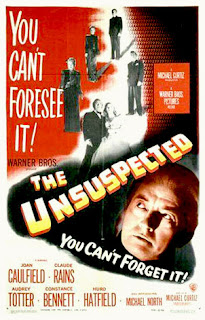(for all dispatches, go here)
We've got 2 B's and an A picture for my eighth dispatch from Noir City. Let's start with the B-side of Wednesday's The Unsuspected double bill, 1947's High Tide.
High Tide stars Lee Tracy, the actor who made the fast-talking newspaperman into a beloved trope. Czar of Noir Eddie Muller told us that by 1947, Tracy's star had become submerged in the hard-drinking lifestyle most befitting the characters he played. "But he had one more great role in him," Eddie said. And this is it. Tracy is excellent here as a guy who'll do anything to get the story, including posing the grieving widow of a gangster for maximum photographic effect.
Tracy's tenacious attempts to bring down the neighborhood gangsters gets him into serious hot water. "What good editor's life hasn't been threatened?" he asks at one point. So for protection, Tracy hires detective Don Castle (whom Eddie called "the poor man's Clark Gable" with good reason). Castle's doesn't seem to have done a good job; High Tide opens with the duo in a car that's just gone over a cliff and landed into the ocean. Castle's pinned under it, and Tracy's got glass sticking out of unpleasant places on his person. When the high tide comes in, it'll submerge them in a watery grave.
From there, the film employs flashback to tell us how we got here. The surprising story was presented to us at the Castro on a crisp 35-mm print that made this Poverty Row picture look sparkling. Watching Tracy manipulate the news evoked thoughts of how the 24-hour
news cycle mimics Tracy's trickery on a much grander, more dangerous
scale. Reporting the news has always been a business first; it's more
about readership (or ratings) than accuracy. Such cynicism works well
here in Noir City, but there's always a nasty jolt when these old
classics feel too timely.
Let's stick with the B's and talk about the meanest man in Hollywood, Noir City veteran Lawrence Tierney.
Not to be confused with that hideous Whitney Houston-Kevin Costner horror movie, The Bodyguard, Bodyguard finds Tierney in a somewhat nicer role than we've come to expect here at Noir City. That's not to say he's not the insubordinate badass we know and love, he's just restrained by Lawrence Tierney standards. Tierney plays Mike Carter, a detective who isn't above punching his superiors out and violating every order they give. Carter's equally surly toward a representative of the very rich Gene Dyson. The rep wants to hire Carter as a bodyguard for Dyson, the head of the very successful Dyson Meatpacking Plant.
Carter wants no part in protecting some rich dude, and is even less interested when he finds out Gene Dyson is really an old lady who wants nothing to do with him. But after an attempt is made on Dyson's life while Carter is at her residence, Carter becomes intrigued. This leads to all sorts of mayhem, including a frame-up and some nasty, gory dealings at the meatpacking plant. The idea of a corrupt meat company as this film's villain should be catnip to any vegetarian.
Tierney is assisted by love interest Priscilla Lane, who manages to bring out his softer side. But don't be fooled! Lane is no easy pushover. "I forget that kittens can still scratch," Carter says of her wily charms. They're a good team in this fun little feature directed by Richard Fleischer and co-written by future director of The Long Goodbye, Robert Altman.
On the A-side of the bill is one of seven pairings of Noir City vets Kirk Douglas and Burt Lancaster. In I Walk Alone, Kirk and Burt are Prohibition-era booze runners who decide to split up when pursued by the law. Kirk gets away, but Burt winds up doing a 14-year bid in the pen. While Burt's rotting away, the only thing that sustains him is the thought that he owns 50% of the successful club Kirk's running. News of the club comes from Kirk's accountant and their mutual friend, Wendell Corey.
When Burt gets out, he learns that Kirk has no plans of cutting him in on this successful business venture. However, Kirk doesn't mind cutting him in on the pleasures of his moll, Noir City legend Lizabeth Scott. Scott's job is to seduce so that Kirk may destroy, but she finds herself drawn to her prey. Especially after she realizes that Kirk's just using her as a side chick; he plays to marry a wealthy older woman who brings business to his club. Suddenly, Burt's not the only one out for revenge.
Director Byron Haskin keeps things tight and tense while Charles Schnee's script manages to wring suspense out of even the most inane dialogue involving the mechanics of accounting. As the accountant caught in the middle of all this, Corey gives the film's most memorable performance, which is saying something considering this cast. Corey would return to Noir City in an even more memorable (and more sinister) role in the astonishing The Accused, which I'll talk about next time.





















